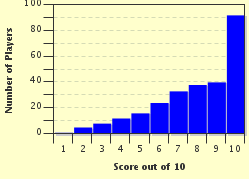Quiz Answer Key and Fun Facts
1. Why this region is French for "Island of France" is unknown since it is not an island. Paris is the dominating city of this region, and it is often misconstrued by non-French people that this region purely consists of Paris and nothing else. Which region is this?
2. Gothic architecture is believed to have started in this former French region that is home to the Gothic Amiens Cathedral, the largest cathedral in Europe. The Battle of the Somme during World War I was fought here. Which region is this?
3. This Mediterranean island region is the birthplace of Napoleon Bonaparte. Its proximity to Sardinia sometimes confuses people who mistake the island for being part of Italy, not France. Which region, which is technically a territorial collectivity, is this?
4. This next region is very mountainous. It is on the border of Switzerland and Italy, and is home to Mont Blanc, the highest mountain in the Alps and mainland Europe outside the Caucasus Mountains. Which region, which is a popular location for the Winter Olympic host cities, is this?
5. Although most French regions have delightful cuisine, this region has quite a number of dishes named after it, most famously a beef dish. Dijon mustard is another food that received its name from a city in this region. The Cote d'Or department is one of France's most famous wine regions. Which region is this?
6. This French region stretches like an arm into the Bay of Biscay. Because this region was routinely invaded by Britain in its history, there is a large portion of its culture influenced by the British and Celts. In fact, most of the signs in this region are written in French and Breton, the local language. Which region, the westernmost in mainland France, is this?
7. Prior to its merger with Languedoc-Roussillon in 2016, this region was famous for having a large city, Toulouse, serve as its base. The rest of the region is largely mountainous or rural. There was a stereotype in France that this region lacked an identity of its own, but officials have worked hard to counteract this and claim much of its culture comes from the individuals who were born there, including Toulouse-Lautrec. Occitan is a once-banned language that is now spoken and celebrated there. Which region merged with Languedoc-Roussillon?
8. This landlocked region is home to an unusually large amount of volcanoes for Europe, although none of them have erupted for at least a couple millennia. The region is sometimes stereotyped as boring and having a lot of elderly people live there. It is largely agricultural, with much of the economy focusing on local cheeses like saint-nectaire. Which region is this?
9. This former French region is in the very north of the country and borders Belgium. It is known for having some Dutch influences, and for its proximity to Dover in Britain. On some days, the famous White Cliffs of Dover can be seen from here. The Cote d'Opale, a cliffy area with beaches, is located in this region. Which region is this?
10. This final French region is perhaps best known for Eleanor, who was queen consort of both France and England as well as duchess of the region. Geographically, this region borders Spain, is home to part of the Pyrenees region of France, and has a large minority of Basque people. Which region is this?
Source: Author
Joepetz
This quiz was reviewed by FunTrivia editor
Pagiedamon before going online.
Any errors found in FunTrivia content are routinely corrected through our feedback system.
